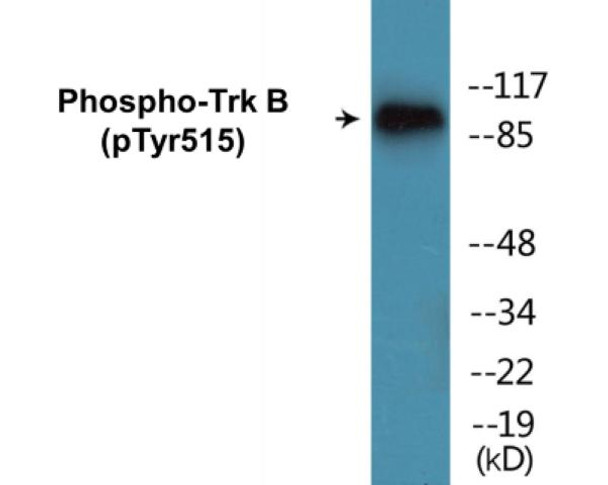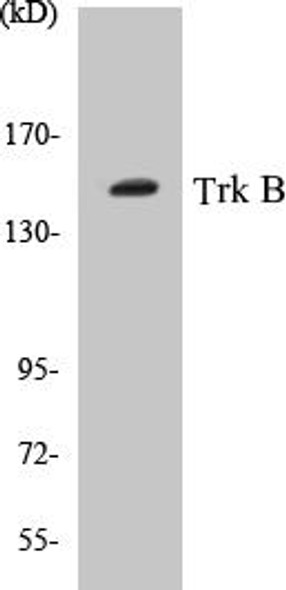Description
| Product Name: | Trk B (Phospho-Tyr515) Colorimetric Cell-Based ELISA |
| Product Code: | CBCAB00395 |
| ELISA Type: | Cell-Based |
| Target: | Trk B (Phospho-Tyr515) |
| Reactivity: | Human, Mouse, Rat |
| Dynamic Range: | > 5000 Cells |
| Detection Method: | Colorimetric 450 nm |
| Format: | 2 x 96-Well Microplates |
The Trk B (Phospho-Tyr515) Colorimetric Cell-Based ELISA Kit is a convenient, lysate-free, high throughput and sensitive assay kit that can detect Trk B protein phosphorylation and expression profile in cells. The kit can be used for measuring the relative amounts of phosphorylated Trk B in cultured cells as well as screening for the effects that various treatments, inhibitors (ie. siRNA or chemicals), or activators have on Trk B phosphorylation.
Qualitative determination of Trk B (Phospho-Tyr515) concentration is achieved by an indirect ELISA format. In essence, Trk B (Phospho-Tyr515) is captured by Trk B (Phospho-Tyr515)-specific primary antibodies while the HRP-conjugated secondary antibodies bind the Fc region of the primary antibody. Through this binding, the HRP enzyme conjugated to the secondary antibody can catalyze a colorimetric reaction upon substrate addition. Due to the qualitative nature of the Cell-Based ELISA, multiple normalization methods are needed:
| 1. | A monoclonal antibody specific for human GAPDH is included to serve as an internal positive control in normalizing the target absorbance values. |
| 2. | Following the colorimetric measurement of HRP activity via substrate addition, the Crystal Violet whole-cell staining method may be used to determine cell density. After staining, the results can be analysed by normalizing the absorbance values to cell amounts, by which the plating difference can be adjusted. |
| Database Information: | Gene ID: 4915, UniProt ID: Q16620, OMIM: 600456, Unigene: Hs.494312/Hs.712776 |
| Gene Symbol: | NTRK2 |
| Sub Type: | Phospho |
| UniProt Protein Function: | TrkB: a receptor tyrosine kinase of the Trk family. Receptor for brain-derived neurotrophic factor (BDNF), neurotrophin-3, -4 and -5 but not nerve growth factor (NGF). Involved in the development and maintenance of the nervous system. Three splice variant isoforms have been described. |
| UniProt Protein Details: | Protein type:Membrane protein, integral; Kinase, protein; Protein kinase, TK; EC 2.7.10.1; Protein kinase, tyrosine (receptor); TK group; Trk family Chromosomal Location of Human Ortholog: 9q22.1 Cellular Component: cell surface; rough endoplasmic reticulum; integral to plasma membrane; dendritic spine; terminal button; excitatory synapse; perikaryon; cytosol; postsynaptic membrane; growth cone; presynaptic active zone; endosome membrane; receptor complex Molecular Function:brain-derived neurotrophic factor receptor activity; neurotrophin binding; protein homodimerization activity; ephrin receptor binding; brain-derived neurotrophic factor binding; ATP binding Biological Process: circadian rhythm; mechanoreceptor differentiation; peptidyl-tyrosine phosphorylation; retinal rod cell development; nerve growth factor receptor signaling pathway; protein amino acid autophosphorylation; neuron migration; regulation of dendrite development; regulation of neurotransmitter secretion; positive regulation of synaptic transmission, glutamatergic; neuron differentiation; positive regulation of MAPKKK cascade; positive regulation of cell proliferation; oligodendrocyte differentiation; feeding behavior; negative regulation of neuron apoptosis; inflammatory response; vasculogenesis; neuromuscular junction development; central nervous system neuron development; aging; response to light stimulus; brain-derived neurotrophic factor receptor signaling pathway; adenylate cyclase activation; regulation of protein kinase B signaling cascade; learning; positive regulation of peptidyl-serine phosphorylation; positive regulation of phosphoinositide 3-kinase cascade; peripheral nervous system neuron development; long-term memory; glutamate secretion; positive regulation of axonogenesis; cerebral cortex development; transmembrane receptor protein tyrosine kinase signaling pathway Disease: Obesity, Hyperphagia, And Developmental Delay |
| NCBI Summary: | This gene encodes a member of the neurotrophic tyrosine receptor kinase (NTRK) family. This kinase is a membrane-bound receptor that, upon neurotrophin binding, phosphorylates itself and members of the MAPK pathway. Signalling through this kinase leads to cell differentiation. Mutations in this gene have been associated with obesity and mood disorders. Alternative splicing results in multiple transcript variants. [provided by RefSeq, May 2014] |
| UniProt Code: | Q16620 |
| NCBI GenInfo Identifier: | 2497560 |
| NCBI Gene ID: | 4915 |
| NCBI Accession: | Q16620.1 |
| UniProt Secondary Accession: | Q16620,Q16675, Q59GJ1, Q8WXJ5, Q8WXJ6, Q8WXJ7, B1ANZ4 B4DFV9, |
| UniProt Related Accession: | Q16620 |
| Molecular Weight: | 822 |
| NCBI Full Name: | BDNF/NT-3 growth factors receptor |
| NCBI Synonym Full Names: | neurotrophic tyrosine kinase, receptor, type 2 |
| NCBI Official Symbol: | NTRK2 |
| NCBI Official Synonym Symbols: | TRKB; trk-B; GP145-TrkB |
| NCBI Protein Information: | BDNF/NT-3 growth factors receptor; tyrosine kinase receptor B; tropomyosin-related kinase B; BDNF-tropomyosine receptor kinase B |
| UniProt Protein Name: | BDNF/NT-3 growth factors receptor |
| UniProt Synonym Protein Names: | GP145-TrkB; Trk-B; Neurotrophic tyrosine kinase receptor type 2; TrkB tyrosine kinase; Tropomyosin-related kinase B |
| Protein Family: | BDNF/NT-3 growth factors receptor |
| UniProt Gene Name: | NTRK2 |
| UniProt Entry Name: | NTRK2_HUMAN |
| Component | Quantity |
| 96-Well Cell Culture Clear-Bottom Microplate | 2 plates |
| 10X TBS | 24 mL |
| Quenching Buffer | 24 mL |
| Blocking Buffer | 50 mL |
| 15X Wash Buffer | 50 mL |
| Primary Antibody Diluent | 12 mL |
| 100x Anti-Phospho Target Antibody | 60 µL |
| 100x Anti-Target Antibody | 60 µL |
| Anti-GAPDH Antibody | 60 µL |
| HRP-Conjugated Anti-Rabbit IgG Antibody | 12 mL |
| HRP-Conjugated Anti-Mouse IgG Antibody | 12 mL |
| SDS Solution | 12 mL |
| Stop Solution | 24 mL |
| Ready-to-Use Substrate | 12 mL |
| Crystal Violet Solution | 12 mL |
| Adhesive Plate Seals | 2 seals |
The following materials and/or equipment are NOT provided in this kit but are necessary to successfully conduct the experiment:
- Microplate reader able to measure absorbance at 450 nm and/or 595 nm for Crystal Violet Cell Staining (Optional)
- Micropipettes with capability of measuring volumes ranging from 1 µL to 1 ml
- 37% formaldehyde (Sigma Cat# F-8775) or formaldehyde from other sources
- Squirt bottle, manifold dispenser, multichannel pipette reservoir or automated microplate washer
- Graph paper or computer software capable of generating or displaying logarithmic functions
- Absorbent papers or vacuum aspirator
- Test tubes or microfuge tubes capable of storing ≥1 ml
- Poly-L-Lysine (Sigma Cat# P4832 for suspension cells)
- Orbital shaker (optional)
- Deionized or sterile water
*Note: Protocols are specific to each batch/lot. For the correct instructions please follow the protocol included in your kit.
| Step | Procedure |
| 1. | Seed 200 µL of 20,000 adherent cells in culture medium in each well of a 96-well plate. The plates included in the kit are sterile and treated for cell culture. For suspension cells and loosely attached cells, coat the plates with 100 µL of 10 µg/ml Poly-L-Lysine (not included) to each well of a 96-well plate for 30 minutes at 37°C prior to adding cells. |
| 2. | Incubate the cells for overnight at 37°C, 5% CO2. |
| 3. | Treat the cells as desired. |
| 4. | Remove the cell culture medium and rinse with 200 µL of 1x TBS, twice. |
| 5. | Fix the cells by incubating with 100 µL of Fixing Solution for 20 minutes at room temperature. The 4% formaldehyde is used for adherent cells and 8% formaldehyde is used for suspension cells and loosely attached cells. |
| 6. | Remove the Fixing Solution and wash the plate 3 times with 200 µL 1x Wash Buffer for five minutes each time with gentle shaking on the orbital shaker. The plate can be stored at 4°C for a week. |
| 7. | Add 100 µL of Quenching Buffer and incubate for 20 minutes at room temperature. |
| 8. | Wash the plate 3 times with 1x Wash Buffer for 5 minutes each time. |
| 9. | Add 200 µL of Blocking Buffer and incubate for 1 hour at room temperature. |
| 10. | Wash 3 times with 200 µL of 1x Wash Buffer for 5 minutes each time. |
| 11. | Add 50 µL of 1x primary antibodies Anti-Trk B (Phospho-Tyr515) Antibody, Anti-Trk B Antibody and/or Anti-GAPDH Antibody) to the corresponding wells, cover with Parafilm and incubate for 16 hours (overnight) at 4°C. If the target expression is known to be high, incubate for 2 hours at room temperature. |
| 12. | Wash 3 times with 200 µL of 1x Wash Buffer for 5 minutes each time. |
| 13. | Add 50 µL of 1x secondary antibodies (HRP-Conjugated AntiRabbit IgG Antibody or HRP-Conjugated Anti-Mouse IgG Antibody) to corresponding wells and incubate for 1.5 hours at room temperature. |
| 14. | Wash 3 times with 200 µL of 1x Wash Buffer for 5 minutes each time. |
| 15. | Add 50 µL of Ready-to-Use Substrate to each well and incubate for 30 minutes at room temperature in the dark. |
| 16. | Add 50 µL of Stop Solution to each well and read OD at 450 nm immediately using the microplate reader. |
(Additional Crystal Violet staining may be performed if desired – details of this may be found in the kit technical manual.)






